Explore The Hazara Rama Temple In Hampi And Seek Tranquillity Amidst Eternal Peace In 2026
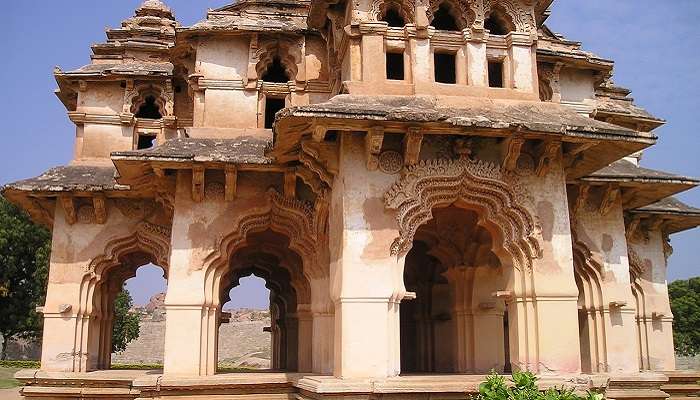
The historical and architectural marvel of The Hazara Rama Temple is located in the ancient city of Hampi in Karnataka. The temple was constructed in the early 15th century when the Vijayanagara Empire ruled the province. “Hazara Rama” translates to “thousand ramas”, depicting the significance of this temple and the portrayal of Lord Rama on the walls of this temple. On the outer walls of this temple, you will find various scriptures from the Hindu Epic of Ramayana, along with horses, elephants and soldiers. The Hazara Rama Temple is a sacred place of worship for all Hindus and is a UNESCO World Heritage Site.
About The Hazara Rama Temple
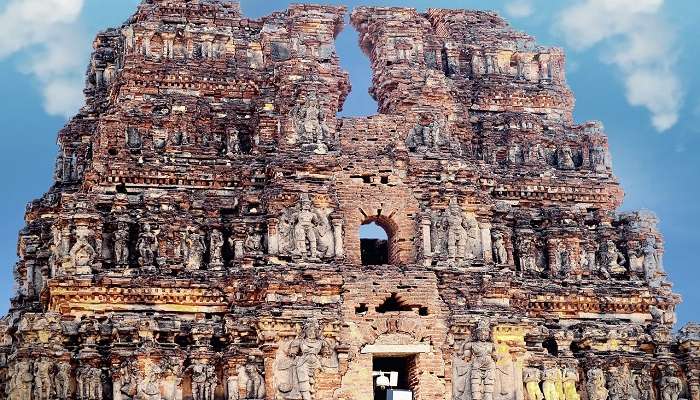
Explore the marvellous ruins of the Vijayanagara Empire’s era, which ruled over Hampi from the 15th to 17th centuries. Travel to Hampi with your friends and family and explore the ruins to learn about the history of this town. The Hazara Rama Temple is a significant archaeological and historical site dedicated to lord Rama and located in the city of Hampi in Karnataka. The Vijayanagara Empire ruled the town from 15th to 17th century.
The temple is widely known for the architectural carvings that depict Ramayana on the walls of this temple. The temple is open daily from 6 AM to 6 PM and does not charge any entry fee. You might get to witness some of the finest celebrations during the festivals of Dussehra and Diwali. Dussehra is a major Hindu festival which is celebrated with great zeal here. The procession includes festivities with dance, music and prayers offered to lord Rama, lord Hanuman and Goddess Sita.
Also Read: Places To Visit In Hampi
History Of The Hazara Rama Temple
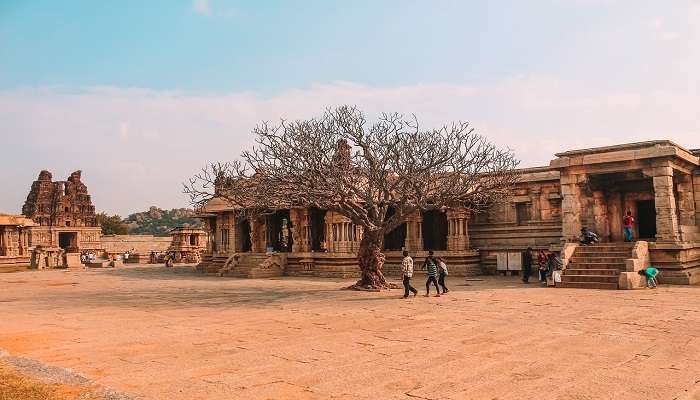
The Hazara Rama Temple is said to have been built around the 15th century by King Devaraya II, the then-ruler of the Vijayanagara Empire. Initially, the temple was built as a simple sanctum but was renovated to include some lavish features. The scriptures carved on the walls of this temple are dedicated to Lord Rama. The temple is known for its Dravidian architectural style, which was most prevalent then.
Today, the ruins of this temple and all other architectural sites portray magnificent cultural heritage. Going further back, the town was ruled by the Mauryan Empire in the third century BCE. Hampi was the capital city of four different empires in that era.
Location: 8F99+4G2, Karnataka 583239, India
Temple Timings: 6 AM – 6 PM on all days
Other Famous Sites In Hampi
The splendid stone chariot in Hampi is a must-see. Look at some other places that you can’t miss.
1. Vijay-Vittala Temple

Vijaya Vittala Temple is yet another temple in Hampi dedicated to lord Vitthala, a reincarnation of lord Vishnu. The temple is widely known for its mesmerising architecture, and you can explore various other places nearby. This architectural marvel is a UNESCO World Heritage site and a popular tourist destination. The temple opens at 8:30 AM, and it is recommended that you visit during the early morning hours when you can expect fewer crowds and a more relaxed atmosphere.
Furthermore, you can avoid rush hour, which is from 11 AM to 3 PM. The doors remain open until 5:30 in the evening, when the crowd also thins out. You can witness the cultural festival of Purandaradasa in January or February (according to the Hindu Calendar). It is also believed that the temple most likely hosted the annual chariot festival in the past.
Location: Hampi, Nimbapura, Karnataka
Entry Fee: INR 30 for adults in India and INR 500 for adults from other countries.
Timings: 8:30 AM – 6 PM
Related Post: Famous Historical Places In India
2. Monolithic Bull
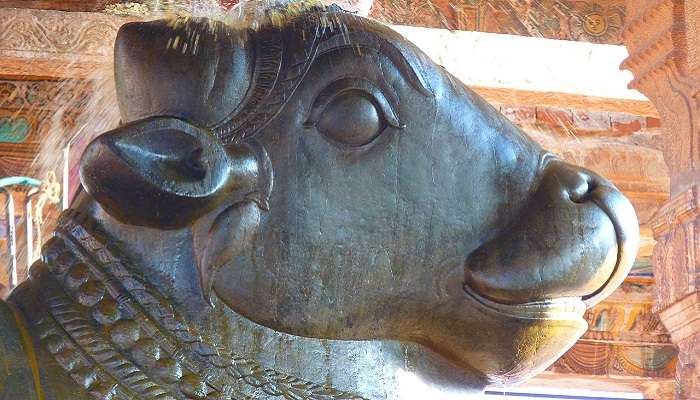
The Monolithic Bull, widely known as Nandi, is a massive single-stone structure considered one of India’s most significant sculptures. The sculpture is located at the base of Matanga Hill and is carved out of a single piece of giant rock. According to Hindu mythology, Nandi is the medium of transportation for Lord Vishnu and a symbolic part of this mythology portraying strength, loyalty, and protection. You can approach the monolith and click as many pictures as possible without an entry fee or additional photography charges. Religious texts describe the creation of Nandi by lord Vishnu from the bones of the sage Shilada.
The construction of this site was a tribute to them, but the date of its construction is not accurately known. It was most likely built between the 14th and 16th centuries. Legends say that Nandi cursed King Ravana, which led to the destruction of his kingdom by the monkey army led by Lord Hanuman.
Location: Nimbapura, Hampi, Karnataka
Entry Fee: No Entry Fee
Timings: 7 AM – 8 PM
3. Lotus Mahal

Lotus Mahal is also a beautiful historical monument from the Vijayanagar Empire, influenced by Islamic architecture. It was created as a regal palace for royal women of the empire. It was a recreational palace for the royal ladies and a meeting place for the king and all his ministers. The palace escaped and survived the major invasions of Hampi and is, therefore, a well-preserved structure from this era. Some of the greatest architectural features, including a lavish water tank and water pipes through beams and columns, kept the palace calm.
The Mahal has eight pyramidal towers, each with a unique lotus-like appearance, hence the name. These towers majestically signify the connection between earthly and divine empires, with a symmetrical and uniform structure throughout. In addition to adding to the beauty, the structures also served the functional purpose of storage and security.
Location: Hampi, Karnataka
Entry fee: INR 10 per person for Indians and INR 250 per person for foreign nationals
Timings: 8 AM – 6 PM
Related Post: Places To Visit In Karnataka In Winter
4. Tungabhadra River
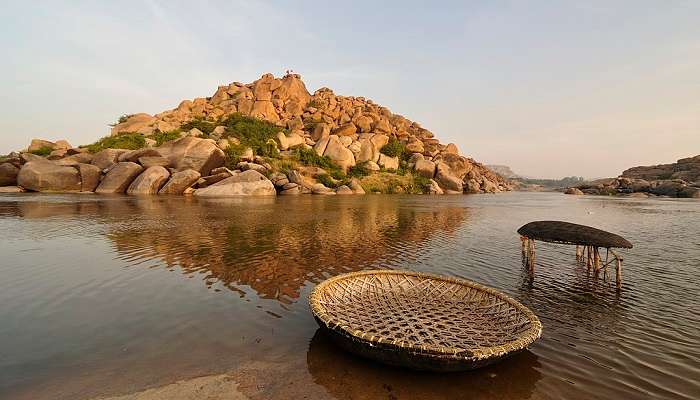
The Tungabhadra River is a major river in the southern peninsular region flowing through the significant states of Karnataka and Andhra Pradesh. Its total length is 531 km, and various dams and reservoirs have been built on it. The river served as an essential water source for the Vijayanagara Empire since the city of Hampi is located on its banks. Today, the river makes an invaluable contribution to the economy of this region due to its significant contributions to agriculture and hydroelectric power generation.
It also serves as a vital source of drinking water around this region and supplies industrial demands. The major tributaries of this river include the Varada River and Vedathy River. In olden times, this river was known as the Verada River, later renamed Tungabhadra.
Location: Karnataka and Andhra Pradesh
Entry Fee: No entry fee
Timings: Open all day
You May Also Like To Read: Temples In Madurai
Hampi is a town that has a great history, and it is full of temples and monuments that reflect the culture of the great kingdoms that once ruled these lands. Now that you have a list of things to remember for your next vacation to Hazara Rama Temple, plan your trip to Karnataka to these fabulous spots for the experience of a lifetime. With a trip to Hampi, you can explore the ancient town for all it is worth. Don’t miss out on these opportunities, and book your tickets now!
For our editorial codes of conduct and copyright disclaimer, please click here.
Cover Image Credit: Simon for Pixabay
Frequently Asked Questions About Hazara Rama Temple
Who built the Hazara Rama Temple?
The Hazara Rama Temple was built around the 15th century by the king of the Vijayanagara Empire. Originally, it was constructed as a simple structure, which was later renovated to include a lavish porch and beautiful pillars.
What is the meaning of the Hazara Rama Temple?
Hazara Rama signifies thousand lord Ramas referring to the beautiful portrayal of Ramayana inscribed on the wall of this temple. The temple was a private worshipping place for the people of the royal family.
What was Hampi formerly known as?
the older names of Hampi were derived from the name of “Tungabhadra River Pampa” and were known as Pampa Kshetra, Kishkindha Kshetra and Bhaskara Kshetra.
Why is Hampi also called the lost city?
Initially, it started with the invasion of the city and the defeat of the Vijayanagara Empire which was broken down to ruins. The city remains were not of any significance until the early 19th century when the British Empire discovered and looted it all. Hereafter, the city remained an abandoned site for a long time.
What is the legend surrounding Hampi?
Hampi is considered to be the birthplace of Lord Hanuman and houses a beautiful Hanuman temple on the top of a hill which is also known as the Monkey temple.
People Also Read:
Dwarahat Temple Narasimha Temple Sas Bahu Temple

Unveil the hidden treasures of the globe and turn every travel dream into reality. As a Content Writer, I am passionate enough to craft stories from ancient wonders to modern marvels. My words paint the picture-perfect itinerary for unforgettable experiences. Let my words be your trusted guide to immerse in the diverse culture and discover the beauty of the unknown.











